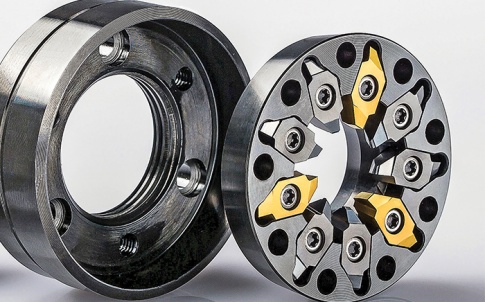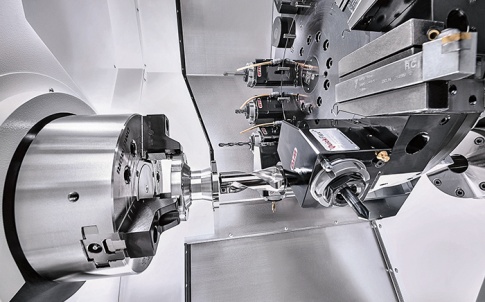Automation and easy integration continue to influence production equipment development. For example, DMG Mori has introduced a mobile robotic cell, Robo2Go, to automate turning. The unit loads raw billets from a tray and unloads machined components automatically, and can be relocated easily by pallet truck to serve four lathes sequentially. Operation, says DMG, requires no specialist knowledge of robots, as graphics-based programming is via a Powertool app running directly in the Celos machine tool control interface; the operator merely enters the workpiece dimensions, selects chuck and gripper, chooses one of the pre-defined workpiece tray arrangements and starts the automatic process.
“This intuitive way of programming a robot is especially suitable for SMEs that want to exploit the competitive advantage of flexible, unattended production,” observed Silvio Krüger, CEO of DMG Mori Systems. “Reluctance to automate has been noticeable in this customer segment, partly because of a lack of programming knowledge and also due to uncertainty that the robot would be fully utilised. It caused some to regard such an investment as risky, but the simplicity of Robo2Go has overcome this.” The equipment allows free access to the working area of the lathe for setting up; a laser scanner system slows or stops any robot movement if operators encroach on the defined safety area.
EMO 2017 in September reflected the attraction of automation. Presentations included the Nakamura-Tome WY-150, a twin spindle twin turret machine configured with what is said to be the world’s fastest high-speed gantry; and Mazak’s UK-manufactured Quick Turn 250MY + TA-12/200, a turning centre linked to a Fanuc robot for loading. This integrated machine loading solution addresses applications requiring prolonged unmanned running. Both the machine tool and the robot are controlled from the Mazak SmoothG CNC, providing a seamless operator interface and enabling fast set-up.

The TA-12/200 is equipped with separate grippers for loading and unloading; a workpiece stacking principle uses interchangeable workpiece support pillars, with layout and set-up guided by a GUI integrated into the SmoothG CNC. Alongside this set-up at EMO were a QT-PRIMOS 150 SG 2-axis machine; and a MULTIPLEX W-300Y + GL-200, a twin-spindle, two-turret machine – each equipped with gantry loaders.
Turn-mill developments
The Nakamura and Mazak displays also illustrated the continuing significance of multitasking machines. Latest developments include DMG Mori’s move to combine the speed of multi-spindle automatic turn-milling with the versatility of sliding-headstock technology. Two new machines – the Multisprint 25 and Multisprint 36 – can make components from bar of up to 25mm and 3mm diameter respectively. The larger machine can also turn chuck parts up to 50mm diameter – a process that can be automated by one or two robots in the working area. The machines are currently being tested for 12 months by five selected customers under production conditions, with commercial release due in early 2018.
Turn-mill sliding head machines are of course well established in the field, with Citizen Machinery, one of the leading protagonists, providing many illustrations of the value of this continually developing technology. One example can be found at HPC Services, based near Derby, which has ordered the latest Cincom L20-VIIILFV turn-mill centre from the company. LVF stands for low frequency vibration, and by including this feature in the machine specification, HPC managing director Paul Cobb believes production using high performance materials such as 321 corrosion resistant and 416 chromium steel can be significantly improved, enabling it to competitively quote on new work, which would previously have been declined.
The patented LFV process enables selected operational sequences to be programmed, in terms of chip size, at the machine control. It is now being used to transform production over a wide range of material types and is said to eliminate problems such as ‘bird-nesting’; improve depth-of-cut and surface finish; delay the onset
of built-up edge on tooling; and dramatically aid the management of swarf. It can be applied to turning, profiling, facing, taper and interrupted cutting sequences plus drilling and even thread cutting.
Keeping it simple
Sophistication and automation are not appropriate in every circumstance, and many small niche manufacturing companies are still taking their first steps into CNC. PGS Precision Engineering specialises in bespoke gunsmithing. A move from one-offs to higher volumes, prompted investment in an XYZ SLX 355 Proturn lathe from XYZ Machine Tools. Attractions include ease of use of the Prototrak control system; the tracking facility allows the operator to manually run through the program using the handwheels before pressing cycle start. The SLX 355 can also be operated as a manual machine; while 95 per cent of the work is programmed the bespoke nature of the products calls for manual intervention to achieve ‘final fit’.

Modular thread whirling
with turbo options
Horn has introduced tools for thread whirling, having six or nine inserts, providing an efficient, cost-effective way to produce single- and multi-start external threads and profiles. Very short cycle times are achievable when used on sliding-head lathes and the process offers other significant advantages over single-point thread cutting.
With its base carriers and ring cassettes, the new type M271 modular tool system offers a multitude of combinations tailored to the various Swiss-type lathes and drive units on the market. The S271 high-precision system allows customers to choose between conventional whirling with six or nine indexable inserts per ring cassette; or the new Horn turbo whirling method, which uses nine precision-ground, double-edged indexable inserts. Three are for roughing, the remainder being finishing inserts, and all are tailored to the thread profile and material to be machined. Each cutting edge is subject to
equal load, an additional factor in extending tool life. Inserts are held accurately in place by a Torx screw, achieving maximum rigidity and precise indexing. Thus handling is optimised during insert replacement in the new modular whirling heads or conventionally in Mono block tools.
Dedicated to stainless steel
Sandvik Coromant is introducing a dedicated turning insert GC2220 in response to challenges associated with stainless steel workpieces. The insert is designed to offer higher resistance to plastic deformation and provide greater edge line security. (Plastic deformation takes place when the tool material becomes soft, typically as a result of elevated cutting temperatures.) GC2220 is a CVD-coated gradient sintered carbide designed specifically for semi-finishing to rough turning under stable conditions where higher wear resistance is required. Inveio coating from Sandvik Coromant is deployed to provide unidirectional crystal orientation in the alumina coating layer, delivering higher levels of wear resistance and tool life. This advanced and proprietary technology is supported by a columnar MT-TiCN inner coating that is hard and resistant against abrasive wear.
It’s claimed that longer tool life will enable machine shops to reduce their cutting tool inventory. Beneficiaries are said to be customers tasked with external and/or internal turning operations in austenitic and duplex stainless steel components such as pump housings, axles, shafts, seals,valves and flanges. Further materials where the attributes of GC2220 will prove advantageous include martensitic stainless steels and low carbon steels.
Smaller workpiece machining
AC1030U is the latest turning insert development from Sumitomo Electric Hardmetal targeted at high precision small workpiece machining, it covers a wide range of material types where improved levels of surface finish are required. This is achieved by embracing a special high precision grind to the cutting edge and the incorporation of Sumitomo’s Absotech Bronze multi-layer coating, which not only helps resist micro-chipping problems but contributes to extended levels of consistent production.
The grade combines Absotech Bronze PVD coating and Sumitomo’s latest precision ground FYS, a narrow breaker width G-class chipbreaker development to aid chip control and help to ensure a stable operational strategy. AC1030U inserts can be used for both turning and grooving of smaller inner diameter bores on workpieces produced from alloy, stainless and heat-resistant steels, pure iron, mild steels as well as non-ferrous materials where chip control is difficult to manage. Absotech Bronze technology comprises five alternate layers of TiAlSiN and AlTiSiN coatings that are applied to a special tough carbide substrate that has double the fracture resistance of more conventional substrates. The coating has excellent heat and oxidation resistance with high orders of adhesion strength and resistance to peeling-off as ithas improved boundary control between the coating and the carbide substrate.










Water Sector Talent Exodus Could Cripple The Sector
One possible reform to the Asset Management Plan (AMP) system would be to stagger the five year cycle across the ten or so water businesses, so that...